Steel Products
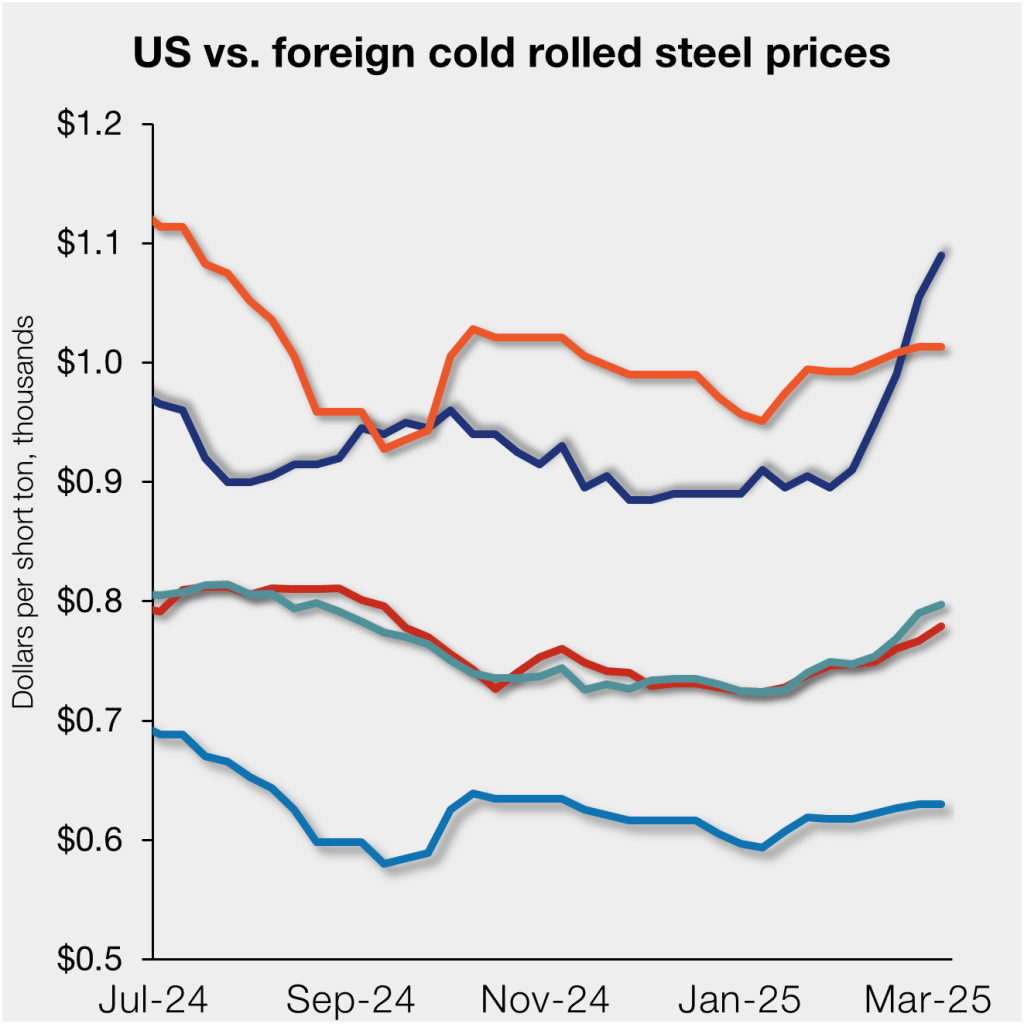
Domestic CRC price gains still outpacing imports
Written by David Schollaert
March 7, 2025
US cold-rolled (CR) coil prices continued to rise this week, well ahead of offshore prices. The price spread between stateside-produced CR and imports reached a 14-month high in the week ended March 7.
Steady price gains in overseas markets continue to be overshadowed by increases in domestic prices. The result? The US premium over imports widened for a fifth straight week.
In our market check on Tuesday, March 4, US CR coil prices averaged $1,090 per short ton (st), a rise of $35/st from the prior week. Prices are up nearly $200/st since late January when mills first started increasing prices, backed by threats of tariffs.
Domestic CR prices are now, theoretically, 33.9% higher than imports. That premium is up from 31% last week and is the highest margin since January 2024.
In dollar-per-ton terms, US CR is, on average, $285/st more expensive than offshore product (see Figure 1) – that’s a $30/st increase w/w. The premium is now just $26/st shy of a recent high of $311/st last January.
The charts below compare CR coil prices in the US, Germany, Italy, South Korea, and Japan. The left side shows prices over the last two years and the right side zooms in to highlight more recent trends.
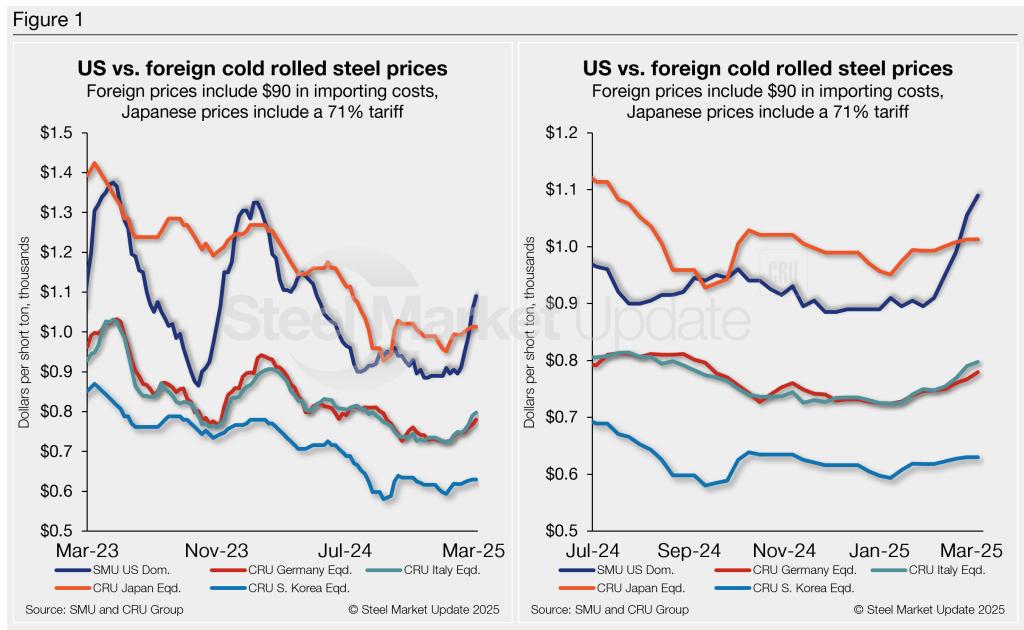
Methodology
This is how SMU calculates the theoretical spread between domestic CR prices (FOB domestic mills) and foreign CR prices (delivered to US ports): We compare SMU’s US CR weekly index to the CRU CR weekly indices for Germany, Italy, and East Asia (Japan and South Korea). This is only a theoretical calculation. Import costs can vary greatly, influencing the true market spread.
We add $90/st to all foreign prices as a rough means of accounting for freight costs, handling, and trader margin. This gives us an approximate CIF US ports price to compare to the SMU domestic CR price. Buyers should use our $90/st figure as a benchmark and adjust up or down based on their own shipping and handling costs. (Editor’s note: If you import steel and want to share your thoughts on these costs, please get in touch with the author at david@steelmarketupdate.com.)
East Asian CR coil
As of Thursday, March 6, the CRU Asian CR price was $540/st, flat w/w and ~$12/st higher than a month earlier. Adding a 71% anti-dumping duty (Japan, theoretical) and $90/st in estimated import costs, the delivered price to the US is $1,013/st. The theoretical landed price of South Korean CR exported to the US is $630/st.
As noted above, the latest SMU CR price is up $35/st to $1,090/st on average, placing US-produced CR theoretically $77/st higher than CR product imported from Japan and $460/st above CR imported from South Korea.
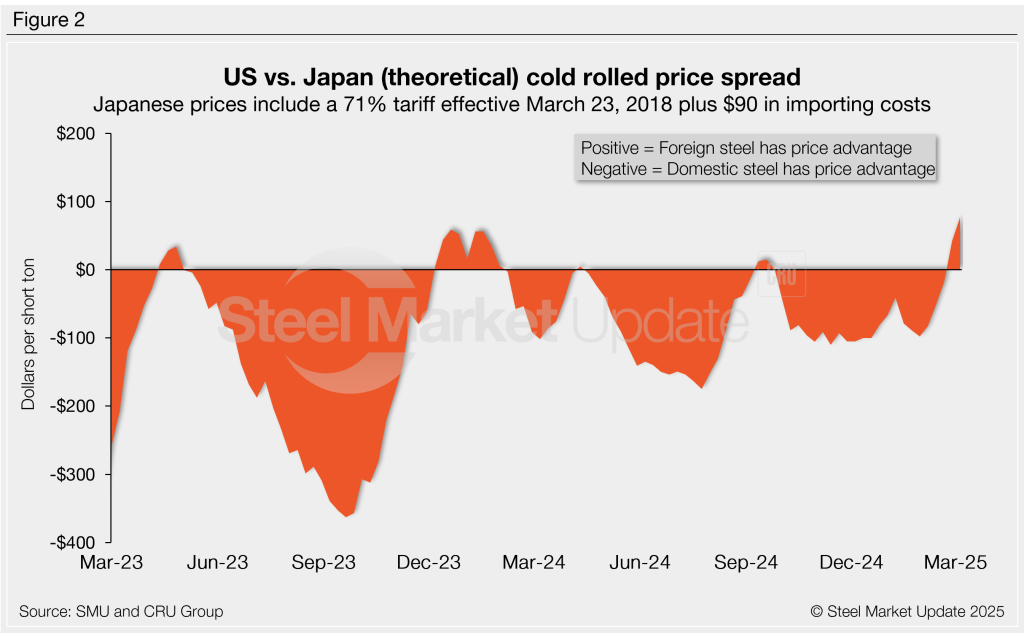
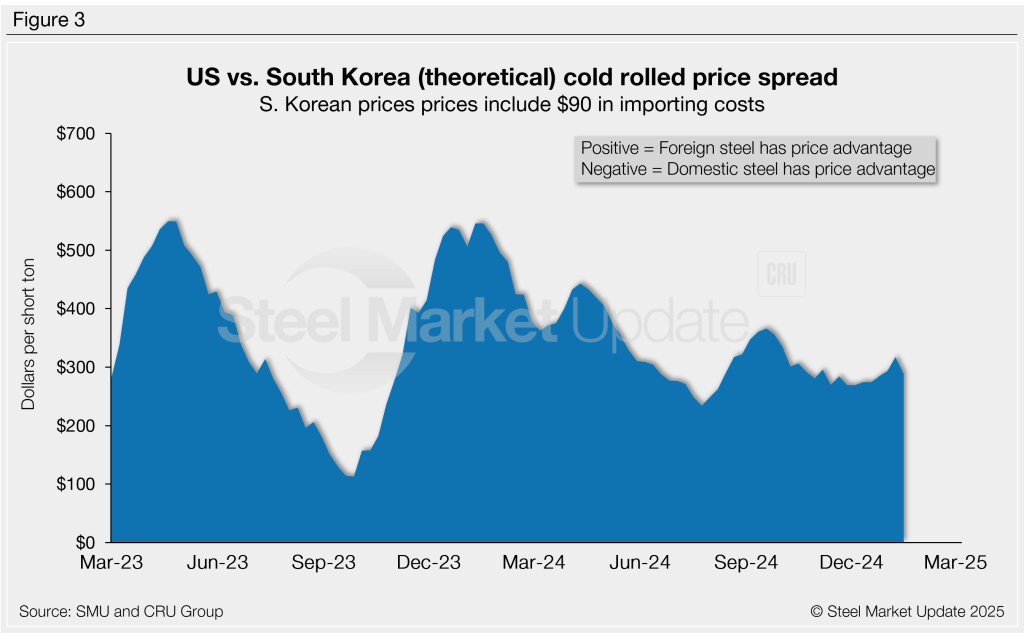
Italian CR coil
Italian CR prices rose $8/st this week to $708/st. After adding import costs, the price of Italian CR delivered to the US is, in theory, $798/st.
That means domestic CR is still theoretically $292/st more expensive than CR coil imported from Italy. The spread is up $27/st vs. last week but still ~$156/st below a recent high of $448/st a year ago.
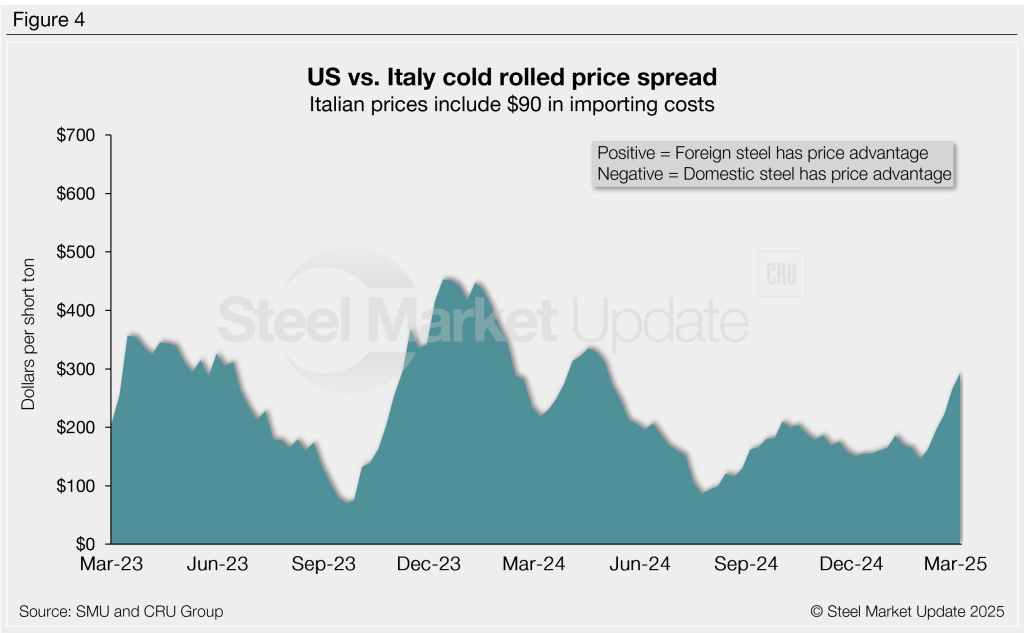
German CR coil
CRU’s German CR price was up $12/st vs. the previous week. After adding import costs, the delivered price of German CR is, in theory, $779/st.
The result: Domestic CR is theoretically $311/st more expensive than CR imported from Germany. The spread is up $23/st w/w but still well below a recent high of $428/st in the first week of 2024.
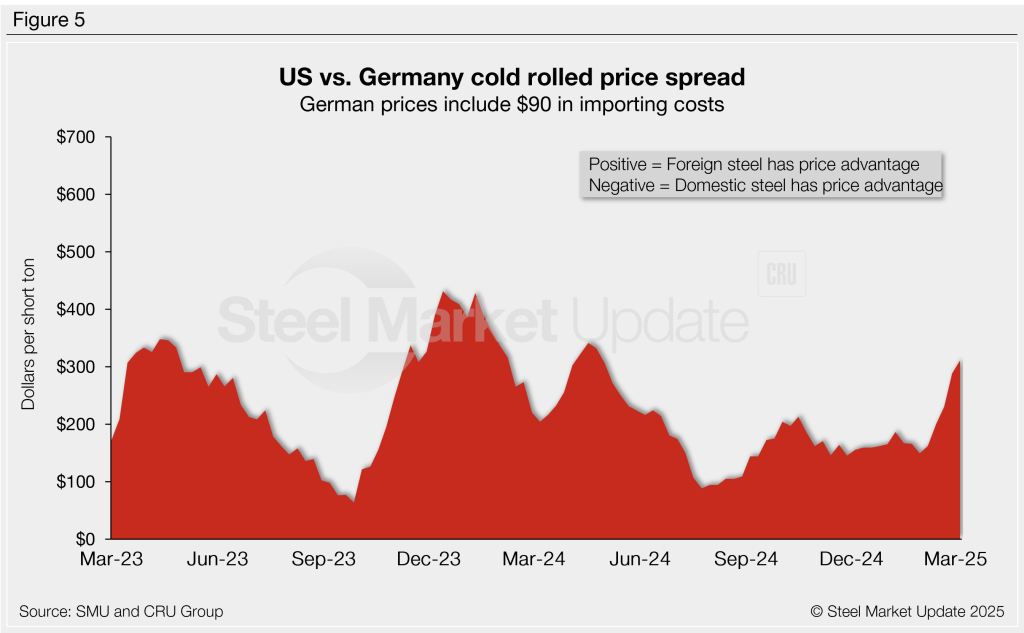
Notes: We reference domestic prices as FOB the producing mill, while foreign prices are CIF the port (Houston, NOLA, Savannah, Los Angeles, Camden, etc.). Inland freight from either a domestic mill or a port is important to keep in mind when deciding where to source from. It’s also important to factor in lead times. In most market cycles, domestic steel will deliver more quickly than foreign steel. Note also that, effective Jan. 1, 2022, the blanket 25% Section 232 tariff was removed from most imports from the European Union. It was replaced by a tariff rate quota (TRQ). Therefore, the German and Italian price comparisons in this analysis no longer include a 25% tariff.

David Schollaert
Read more from David SchollaertLatest in Steel Products
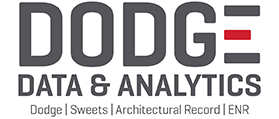
Construction growth slowed in March on tariff woes: Dodge
The decline comes after reaching a record high in January to kickstart the year.
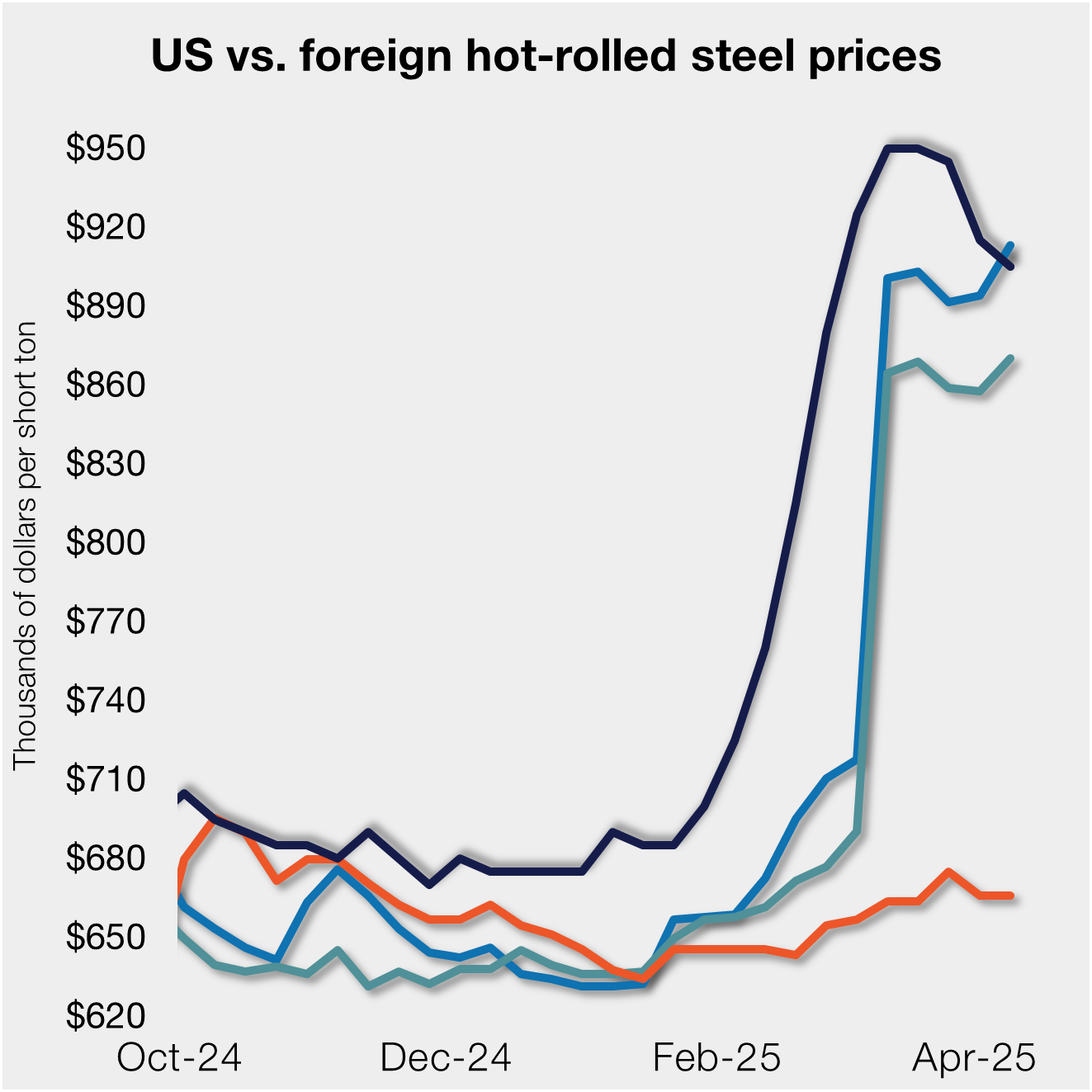
Return of S232 zapped gap between US and EU HR prices, Asian HR remains cheaper
Domestic hot-rolled (HR) coil prices declined this week for a third straight week. Most offshore markets bucked the trend and gained ground. Uncertainty in the US market around tariffs, especially after “Liberation Day,” caused US prices to slip as buyers moved to the sidelines. It’s unclear to date whether the 90-day pause on the more […]

SMU Steel Demand Index momentum slows further
SMU’s Steel Demand Index growth eased again, according to early April indicators. The slowdown comes after the index reached a four-year high in late February.

SMU Community Chat replay now available
The latest SMU Community Chat webinar reply is now available on our website to all members. After logging in at steelmarketupdate.com, visit the community tab and look under the “previous webinars” section of the dropdown menu. All past Community Chat webinars are also available under that selection. If you need help accessing the webinar replay, or if your company […]

US light-vehicle sales accelerate in March
US light-vehicle (LV) sales increased to an unadjusted 1.59 million units in March, more than a 30% surge over February and 10.7% above year-ago totals, according to US Bureau of Economic Analysis data.
